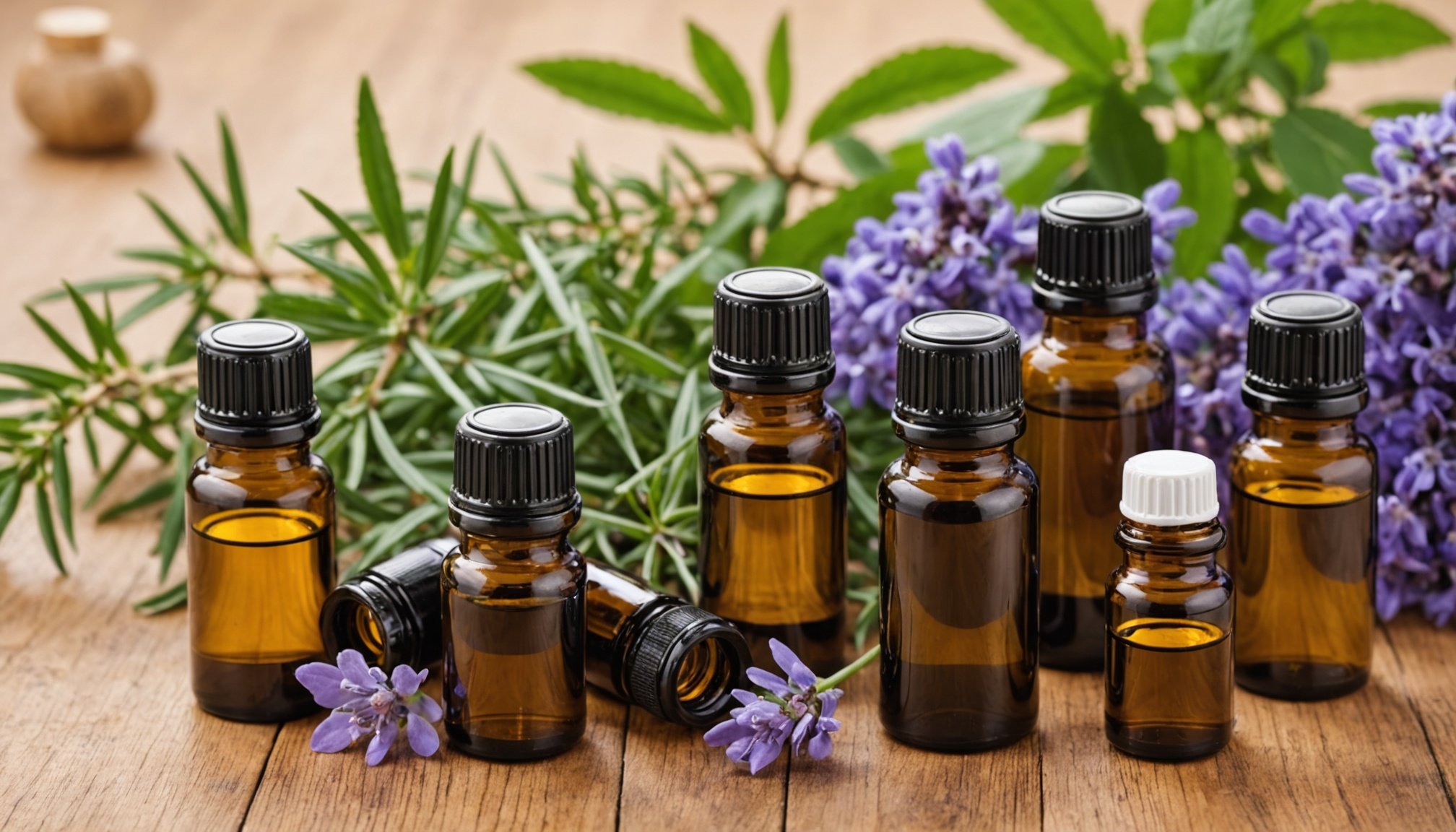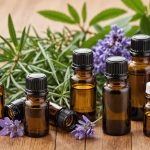Guidelines for Safely Incorporating Essential Oils at Home with Young Children
Using essential oils can be a wonderful way to create a calming and healthy environment for your family, but when it comes to young children, it’s crucial to approach their use with caution and careful consideration. Here’s a comprehensive guide to help you safely incorporate essential oils into your home with babies and children.
Understanding the Risks and Precautions
Before diving into the world of essential oils, it’s essential to understand the potential risks, especially when it comes to young children. Essential oils are highly concentrated extracts from plants, which makes them potent and potentially hazardous if not used correctly.
Also read : Mastering Progressive Muscle Relaxation: Your Ultimate Guide to Overcoming Insomnia
“Essential oils are natural but they still are not all created equal when it comes to our pets and little ones,” notes an article from Home Made Lovely[5].
Skin and Respiratory Issues
Essential oils can cause skin irritation and allergic reactions, particularly in children who have thinner skin and less-developed immune systems. For instance, if essential oils come into contact with the skin, they may result in a rash known as contact dermatitis[2][4].
Also to read : Discover the Transformative Advantages of Adding Mindful Breathing to Your Everyday Life
Ingestion and Poisoning
One of the most critical risks is accidental ingestion. Essential oils can cause serious poisoning, seizures, or even death if swallowed. It is vital to keep essential oils out of reach of children and pets and to ensure they are screwed shut securely[2][4].
Interactions with Medications and Conditions
Essential oils can interact with medications or exacerbate certain health conditions. For example, some oils can affect the liver or kidneys, which could be problematic for children with pre-existing health issues. Always consult with a healthcare professional before using essential oils, especially if your child is on medication or has a medical condition[2][4].
Choosing Safe Essential Oils for Children
Not all essential oils are safe for children, and it’s important to select oils that are known to be gentle and non-irritating.
Recommended Essential Oils
Here are some essential oils that are often considered safe for children, provided they are used correctly:
- Lavender Oil: Known for its calming effects, lavender oil can be used in aromatherapy or diluted with a carrier oil for topical use. It is often recommended for teething pain and promoting sleep[3][4].
- Chamomile Oil: Chamomile is another calming oil that can be used for teething and soothing skin irritations. However, it should be used in very diluted form and with caution[3][4].
Essential Oils to Avoid
There are several essential oils that should be avoided around children due to their potential toxicity:
- Eucalyptus: Can irritate the airways and is not recommended for children[2][5].
- Peppermint: While some sources suggest it might be safe, it is generally advised to use with caution due to its potency[2][5].
- Sage: Known to be too potent for young children and can cause adverse reactions[5].
- Birch: Contains methyl salicylate, which is similar to aspirin and can be toxic if ingested or used improperly[5].
How to Use Essential Oils Safely
Using essential oils safely involves several steps to ensure they do not harm your children.
Dilution
Essential oils must be diluted with a carrier oil before being applied to the skin. Here’s a general guideline for dilution:
| Essential Oil | Carrier Oil | Dilution Ratio |
|---|---|---|
| 3 drops of essential oil | 1 teaspoon of carrier oil | 3% solution |
For example, you can mix 3 drops of lavender essential oil with 1 teaspoon of coconut or jojoba oil[3][4].
Patch Testing
Before applying any new essential oil blend to your child’s skin, perform a patch test. Apply a small amount of the diluted oil to a discreet area of the skin and wait 24 hours to see if there is any reaction[2][4].
Aromatherapy
Aromatherapy can be a safe way to use essential oils around children. Use a diffuser to spread the oil particles in the air, but ensure the room is well-ventilated and the child is not too close to the diffuser. Here are some tips for using aromatherapy safely:
- Use the Right Amount: Only use a few drops of essential oil in the diffuser to avoid overwhelming the child.
- Choose Safe Oils: Stick to oils like lavender and chamomile that are known to be calming and safe.
- Monitor the Child: Keep an eye on your child’s reaction to the aromatherapy and stop if they show any signs of discomfort or irritation[3][4].
Practical Tips for Using Essential Oils with Babies
When it comes to babies, the rules are even more stringent due to their sensitive skin and developing immune systems.
Teething Relief
For teething pain, some parents use essential oils in a very diluted form. Here are some tips:
- Dilute Heavily: Use a very low dilution ratio (less than 0.25%) and apply it to the jaw area, not directly on the gums or skin[3][4].
- Avoid Ingestion: Never put essential oils inside a baby’s mouth or on their face. Ingestion can lead to serious health issues[3][4].
Calming Blends
For creating a calming environment, aromatherapy can be very effective. Here’s a simple recipe:
- Lavender and Chamomile Blend: Mix a few drops of lavender and chamomile essential oils in a diffuser to create a soothing atmosphere.
Storage and Safety
Always store essential oils in a cool, dry place away from direct sunlight and out of reach of children. Here are some additional safety tips:
- Label and Store Properly: Ensure each bottle is clearly labeled and stored securely.
- Educate Family Members: Make sure all family members understand the risks and how to use essential oils safely[2][4].
Real-Life Examples and Anecdotes
Many parents have successfully used essential oils to help their children, but it’s crucial to learn from their experiences.
A Parent’s Experience with Lavender Oil
One parent shared their experience of using lavender oil to help their baby sleep: “I diluted a few drops of lavender oil with coconut oil and applied it to my baby’s skin before bedtime. It really helped her relax and sleep better.”
A Cautionary Tale
Another parent learned the hard way about the importance of patch testing: “I applied undiluted peppermint oil to my child’s skin, thinking it would help with a cold. However, it caused a severe rash. Now, I always do a patch test before using any new essential oil.”
Consulting Healthcare Professionals
Before starting to use essential oils, especially if you have young children, it is advisable to consult with a healthcare professional.
Why Consult a Doctor?
A doctor can help identify any potential health issues that might interact with essential oils and provide personalized advice on safe usage. Here’s what a healthcare professional might say:
“Essential oils can be beneficial, but they are not a replacement for medical care. Always consult with a doctor before using them, especially if your child has any underlying health conditions or is on medication,” advises a healthcare expert[2][4].
Incorporating essential oils into your home can be a wonderful way to promote health and well-being, but it requires careful consideration and adherence to safety guidelines, especially when it comes to young children.
By choosing the right essential oils, diluting them properly, using aromatherapy safely, and consulting healthcare professionals, you can ensure that these natural remedies benefit your family without posing any risks.
Remember, safety always comes first, and with the right knowledge and precautions, you can enjoy the many benefits that essential oils have to offer.
Recommended Dilution Ratios
Understanding dilution ratios is essential for safe usage, especially when handling potent substances like essential oils. Proper dilution minimizes the risk of adverse reactions and maximizes their benefits. Essential oils, by nature, are highly concentrated, and applying them directly can irritate the skin or cause sensitivity.
Importance of Dilution for Safety
When using essential oils, safety should always be the primary concern. Dilution ensures that the oils are used in a manner that is both effective and non-threatening. For adults, a standard dilution ratio is often 2% or approximately 12 drops of essential oil to 30ml of a carrier oil. For children and the elderly, a reduced concentration, such as 1% (6 drops per 30ml), is recommended.
Recommended Dilution Ratios by Age
Adjusting the dilution ratio according to age ensures everyone’s safety:
- Adults: 2% dilution
- Children/Elderly: 0.5% to 1% dilution
- Infants: Essential oils are generally discouraged unless advised by a professional.
Common Diluents and Their Application
Common diluents include carrier oils like coconut oil, jojoba oil, and grapeseed oil. These not only aid in dilution but also nourish the skin. For effective use, simply blend your chosen essential oil with a suitable carrier oil before topical application. This practice ensures that the essential oil’s benefits are delivered safely.
Contraindications and Precautions
When using essential oils, it is crucial to adhere to specific safety measures to prevent adverse effects. Some essential oils should be avoided for children due to their potent nature. For instance, peppermint and eucalyptus oils are not recommended for use with young children as they can cause respiratory distress. Lavender and tea tree oils have also been flagged for their hormonal interactions in children.
Common medical conditions could also present risks when using essential oils. Individuals with asthma may experience exacerbations if they encounter strong scents. Furthermore, those with epilepsy should avoid camphor or rosemary essential oils, which can potentially trigger seizures.
Taking the necessary precautions during the use of essential oils can significantly reduce the likelihood of adverse reactions. It is advised to:
- Always perform a patch test on the skin to check for sensitivities or allergies.
- Use proper dilution of the oils to minimize skin irritation and toxicity.
- Consult a healthcare professional especially if you have underlying health conditions.
Understanding these contraindications ensures that the beneficial properties of essential oils do not come at the cost of your health. By observing these guidelines, you can safely incorporate essential oils into your wellness routine.
Practical Tips for Safe Use
Using essential oils with confidence requires an understanding of safe use practices. Whether applying through diffusion or directly onto the skin, ensuring safety remains paramount.
Application Methods
Different methods of application require specific precautions to fully reap the benefits of essential oils while minimizing risks. Diffusion is a popular method where the oil is dispersed into the air. Always use a diffuser in a well-ventilated area, and limit usage to 60 minutes. Topical application involves applying oils directly to the skin. It’s crucial to dilute essential oils with a carrier oil to prevent skin irritation. Typically, a concentration of 2-3 drops of essential oil per teaspoon of carrier oil is recommended.
Proper Storage Practices
To maintain the integrity and effectiveness of essential oils, proper storage is essential. Store oils in a cool, dark place, away from direct sunlight. Always keep them in tightly sealed containers out of reach of children and pets. These storage tips ensure the longevity of the oils.
Integrating Oils into Daily Routines
Integrating essential oils into daily routines can be both safe and enjoyable. Use diffusers in common areas to gently fragrance the home, or blend oils into daily moisturizers. Always patch test a new oil on the skin before using it regularly to ensure no allergic reactions occur.
Common Misconceptions About Essential Oils
Essential oils are a popular choice for natural remedies, but numerous misconceptions persist about their effectiveness and safety, particularly concerning children’s safety.
Addressing Myths on Effectiveness
A prevalent myth is that essential oils can cure ailments without any scientific backing. While some essential oils have documented benefits, it is crucial to rely on research-based evidence rather than anecdotal claims.
Clarifying Misinformation on Safe Use
Another misconception is that essential oils are entirely safe due to their natural origin. However, not all essential oils are safe for everyone, especially children. It is imperative to understand the potential risks and adhere to safe usage guidelines. For instance, undiluted essential oils can cause skin irritation or allergic reactions.
Encouraging Informed Choices Through Research
To debunk these misconceptions, investing time in thorough research is essential. This includes consulting credible sources and considering the advice of healthcare professionals. Knowledge empowers users to make informed decisions on the use of essential oils, ensuring safety and maximizing benefits.
Encourage open-mindedness and skepticism, as not all claims about essential oils are based on facts. Always opt for research-backed information to ensure informed and safe choices.
Expert Opinions and Reliable Sources
When navigating the intricate wellness landscape, leveraging expert opinions is crucial. These insights come from health professionals who contribute extensively to the wellness community. Their expertise helps public understand complex topics more clearly.
Health professionals bring invaluable contributions to the table. For instance, dietitians and nutritionists often provide necessary guidance on nutritional needs and balanced diets. Their input is significant not only for personal health but also for community wellness initiatives. Additionally, these professionals utilize scientific data to support their advice, ensuring recommendations are evidence-based.
Furthermore, insights from reputable organizations are key in shaping public understanding. Institutions like the World Health Organization (WHO) and Centers for Disease Control and Prevention (CDC) are recognized reliable sources. They offer detailed reports and guidelines on various health matters, thus fostering informed choices among the masses.
However, while expert opinions and organizations provide a wealth of information, consulting with pediatricians, especially regarding children’s health, remains essential. Pediatricians are particularly valuable as their advice is tailored to individual needs, considering specific medical backgrounds and histories. By regularly engaging with these reliable sources, individuals can make better-informed decisions to improve their well-being.
Alternatives to Essential Oils
In the pursuit of holistic wellness, many parents are keen to explore natural remedies that are safe and effective for children. Essential oils, although popular, may not always be the best choice due to safety concerns, especially for young ones. Therefore, it is essential to consider viable alternatives. These non-oil options are gentle and can be just as beneficial without the risk of adverse reactions.
One alternative is herbal teas, such as chamomile and peppermint. These are well-loved for their calming effects and ease of digestion. For children, diluted herbal infusions offer a natural, soothing remedy. Aromatherapy can also be achieved without oils by using dried herbs or flower sachets.
Choosing alternatives becomes paramount in situations where essential oils might irritate sensitive skin or trigger allergies. Safety should always be the priority, especially in households with young children.
Benefits of using non-oil options for wellness include lower risks of sensitivity reactions, ease of preparation, and the simplicity of sourcing ingredients. Foods like ginger and honey are also esteemed for their wellness properties, aiding in digestion and soothing sore throats. By favouring these natural remedies, caregivers can ensure that wellness regimens remain both effective and safe.
Importance of Safety in Using Essential Oils Around Young Children
Understanding essential oil safety is paramount for parents and caregivers. Child safety should always be a priority, particularly when incorporating essential oils into the home. These natural extracts, while beneficial for adults, require careful consideration when used around young children.
Misconceptions about essential oils can lead to their indiscriminate use. A common belief is that, since they are natural, they are inherently safe for children. However, this is not always the case. Essential oils can be potent, and their precautions need to be thoroughly understood to prevent adverse effects.
Potential risks arise when essential oils are improperly used. For example, applying undiluted oils directly onto a child’s skin can lead to irritations or allergic reactions. Moreover, inhalation of certain oils may cause respiratory issues. Therefore, it is crucial to seek advice from professionals before introducing these substances around children.
To ensure safe essential oils usage:
- Always dilute oils before application.
- Avoid using strong oils like peppermint or eucalyptus for young children.
- Store essential oils out of children’s reach to prevent accidental ingestion.
By adhering to these essential oil precautions, you can enhance the well-being of your home environment without compromising on child safety.
Age-Specific Recommendations for Essential Oils
When considering essential oils for infants, it is paramount to approach with caution. Infants’ sensitive skin requires mild and safe applications. Gentle oils such as chamomile and lavender can be beneficial but must be heavily diluted. For infants aged 0-12 months, use essential oils in a diffuser rather than direct skin application. This method ensures a safe yet effective way to utilise the benefits of essential oils without risking irritation.
As infants grow into toddlers aged 1-3 years, their tolerance to essential oils increases slightly. However, careful selection and dilution are key. Essential oils such as citrus oils and cedarwood can be introduced with appropriate precautions. A recommended dilution ratio for toddlers is about 0.5-2%, significantly lower than that for adults. Always apply diluted oils to the bottoms of feet or diffuse in well-ventilated areas for maximum safety.
For preschoolers aged 3-5 years, essential oil usage requires continued vigilance but allows for slightly expanded options. Oils like peppermint should still be avoided due to their potency, but tea tree and eucalyptus may be utilised with care. Ensure parent supervision is ongoing, emphasising the avoidance of direct ingestion or application near the face. By adhering to age-based precautions, the beneficial effects of essential oils can be safely harnessed for young children.
Safe Essential Oils for Young Children
Choosing the right essential oils for young children is crucial to ensure safety and effectiveness. Kid-friendly oils like lavender, chamomile, and mandarin are excellent options for their calming and soothing properties.
Recommended Essential Oils for Kids
-
Lavender Oil: Known for its calming effects, lavender can help children relax and promote better sleep. It’s ideal for those restless nights or nap times.
-
Chamomile Oil: This oil is gentle on young skin and effective in reducing irritability. Chamomile is also beneficial for soothing digestive discomfort.
-
Mandarin Oil: With its sweet fragrance, mandarin oil is a favourite among children. It’s uplifting while still maintaining a soothing effect on anxiety or nervousness.
Choosing Quality Essential Oils
When selecting essential oils for children, ensure they are of high quality:
-
Pure and Organic: Opt for oils labeled as pure and organic to avoid exposure to harmful chemicals.
-
Child-Friendly Formulations: Look for products specifically designed for children, often indicated on the packaging.
-
Test for Sensitivity: Conduct a patch test to ensure no allergic reactions occur before regular use.
By focusing on these key elements, parents can provide safe and effective essential oil experiences for their young children, ensuring both comfort and peace of mind.
Dilution Guidelines for Essential Oils
When using essential oils, especially for children, proper dilution is crucial to ensure safety and effectiveness. Essential oil dilution involves combining oils with a carrier, which helps to minimise skin irritation and potential adverse reactions.
Importance of Dilution for Children
Children’s skin is significantly more sensitive than adults’, making it essential to adjust the dilution ratios. Undiluted oils can cause irritation or sensitisation, so careful consideration is necessary when applying these potent substances to younger age groups.
Recommended Dilution Ratios
To ensure essential oils are used safely, experts recommend specific dilution ratios depending on the age group:
- For infants up to six months, use 0.1% to 0.2% essential oil dilution. This equates to one drop of essential oil per one to two tablespoons of carrier oil.
- For children aged six months to two years, increase to a 0.25% to 0.5% dilution.
- For children aged two to six years, use a 1% dilution.
Methods of Diluting Essential Oils
Carriers are vital for diluting oils safely. Options include vegetable oils like coconut, almond, or jojoba, which provide a stable medium for the essential oil to disperse. By mixing essential oils with a carrier, you reduce the concentration, ensuring safer application on the skin while still benefiting from their therapeutic properties.
Common Allergic Reactions and Contraindications
Understanding the signs of allergic reactions to essential oils is crucial. Common indicators include redness, itching, and swelling at the site of application. These symptoms can escalate, leading to more severe reactions such as skin blistering or respiratory issues. Immediate identification of these reactions is essential to prevent further complications.
Certain essential oils have known contraindications for young children. Oils like eucalyptus and peppermint should be approached with caution. Their potent nature can potentially cause respiratory distress in minors, making it vital for caregivers to stay informed about these risks.
When introducing a new essential oil, especially for children, the importance of patch testing cannot be overstated. A patch test involves applying a small amount of the essential oil, diluted with a carrier oil, on a small area of the skin. Monitor this area for at least 24 hours to ensure no allergic reaction occurs. This simple step serves as a safeguard against unforeseen allergic responses.
Exploring the world of essential oils can be enriching, but prioritising safety through informed usage practices is paramount. Ensuring essential oil safety reduces health risks while maximising benefits for all, especially the younger members of the family.
Practical Applications of Essential Oils
Implementing essential oils within daily routines can be both enriching and beneficial. Using essential oils safely in a child’s environment requires thoughtful methods, especially when diffusing them. Opt for passive diffusion techniques, such as placing a few drops on a tissue placed out of reach, which mitigates direct exposure. This allows the fragrance to gently fill the space without affecting sensitive young lungs.
In terms of applying oils topically, mastering the balance between safety and effectiveness is crucial. Begin by diluting essential oils with a carrier oil at a child-safe dilution ratio (1-2%), then perform a patch test to ensure there’s no adverse reaction. Common application techniques include gentle massage on non-sensitive areas like arms or legs. Always check for age-appropriate recommendations for specific oils used.
Using essential oils as a component of cleaning products introduces another realm of benefits. These oils are a natural alternative to harsh chemicals, adding a pleasant aroma to cleansers. Incorporate them by mixing with water and vinegar, creating sprays that cut through grime while being safe for surfaces like countertops, especially where children frequent. Choose kid-friendly oils with antimicrobial properties, such as lavender or lemon, enhancing cleanliness without compromising child safety.
Visual Aids and Checklists for Parents
In the quest for safe essential oil usage, visual aids and checklists provide invaluable guidance. Designing easy-reference checklists empowers parents to maintain safety effortlessly. These essential oil checklists break down complex information into digestible bits, allowing quick access to vital safety instructions.
Visual safety guides enhance these checklists, offering clear imagery of essential oils and their safe applications. Parents benefit from visualizing which oils are suitable for specific uses, reducing confusion and ensuring proper implementation. Incorporating such illustrations aids in developing a holistic understanding of safe practices.
Resource tools, tailored for parental use, bridge knowledge gaps. These tools offer insights into essential oil properties, potential hazards, and best practices for safe household usage. Parents can rely on these tools for consistent and reliable information, ensuring they stay updated and aligned with safety protocols.
Furthermore, having resource tools at disposal encourages proactive behaviour, as parents can check potential risks before introducing new oils into their routine. This multifaceted approach to essential oil safety not only prioritizes well-being but also instills confidence in managing home environments effectively. By adopting these visual aids and checklists, parents can create a safer household, fostering informed and mindful essential oil use.











